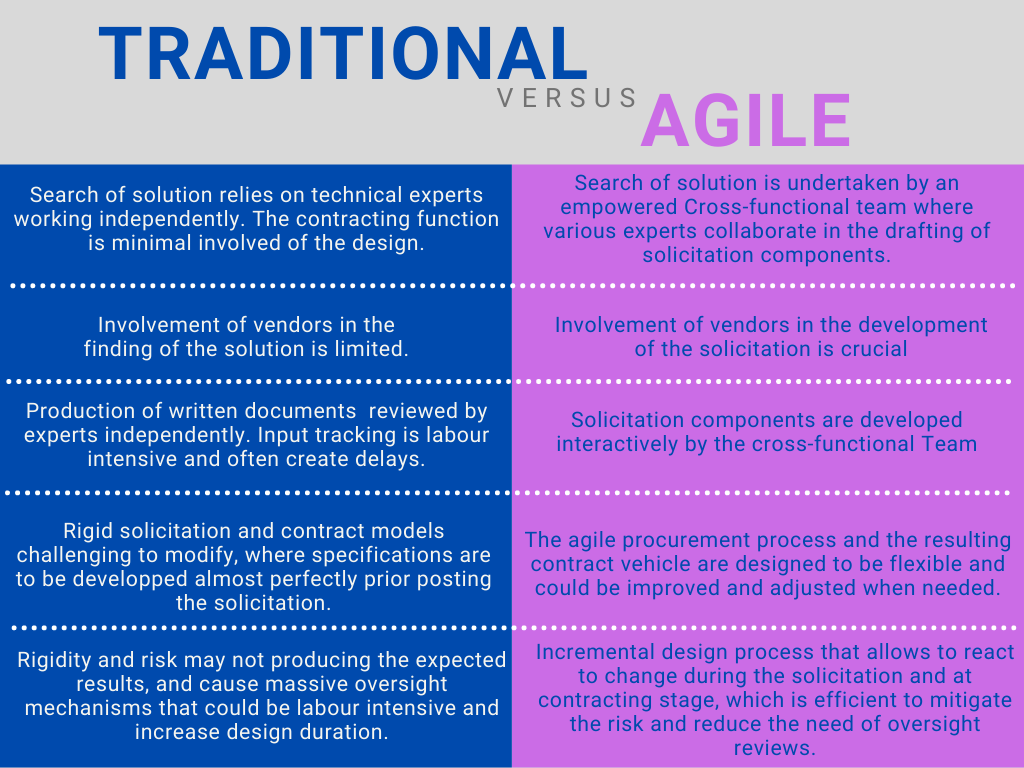Important: The GCConnex decommission will not affect GCCollab or GCWiki. Thank you and happy collaborating!
Difference between revisions of "COEAIPAPP30"
Jump to navigation
Jump to search
| Line 2: | Line 2: | ||
== 12 Principles == | == 12 Principles == | ||
| + | |||
| + | There are 12 agile procurement principles: | ||
| + | |||
| + | # Satisfy the clients through contracts that delivers the expected outcomes. | ||
| + | # Welcome changing requirements, even late in development. Agile processes harness change for the client’s needs satisfaction. | ||
| + | # Deliver working solicitation components frequently, from a couple of weeks to a couple of months, with a preference to the shorter timescale. | ||
| + | # Work together with business people, IT technical and contracting experts daily throughout the solicitation development. | ||
| + | # Build solicitations around motivated individuals and give them the environment and support they need, and trust them to get the job done. | ||
| + | # The most efficient and effective method of conveying information to and within a development team is face-to-face conversation. | ||
| + | # Working solicitation components is the primary measure of progress. | ||
| + | # Agile processes promote sustainable development. The expert team members should be able to maintain a constant pace indefinitely. | ||
| + | # Continuous attention to technical excellence and good design enhances agility | ||
| + | # Simplicity–the art of maximizing the amount of work not done–is essential. | ||
| + | # The best architectures, requirements, and designs emerge from self-organizing teams. | ||
| + | # At regular intervals, the team reflects on how to become more effective, then tunes and adjusts its behavior accordingly. | ||
| + | |||
== Agile vs Traditionnal == | == Agile vs Traditionnal == | ||
| + | |||
| + | [[File:Agile Design.png|400x1000px]] | ||
== Collaborative Design == | == Collaborative Design == | ||
== True Collaboration Approach == | == True Collaboration Approach == | ||
Revision as of 15:45, 21 February 2022
| Home | APP3.0 | Pilots | ScaleUp |
12 Principles
There are 12 agile procurement principles:
- Satisfy the clients through contracts that delivers the expected outcomes.
- Welcome changing requirements, even late in development. Agile processes harness change for the client’s needs satisfaction.
- Deliver working solicitation components frequently, from a couple of weeks to a couple of months, with a preference to the shorter timescale.
- Work together with business people, IT technical and contracting experts daily throughout the solicitation development.
- Build solicitations around motivated individuals and give them the environment and support they need, and trust them to get the job done.
- The most efficient and effective method of conveying information to and within a development team is face-to-face conversation.
- Working solicitation components is the primary measure of progress.
- Agile processes promote sustainable development. The expert team members should be able to maintain a constant pace indefinitely.
- Continuous attention to technical excellence and good design enhances agility
- Simplicity–the art of maximizing the amount of work not done–is essential.
- The best architectures, requirements, and designs emerge from self-organizing teams.
- At regular intervals, the team reflects on how to become more effective, then tunes and adjusts its behavior accordingly.


